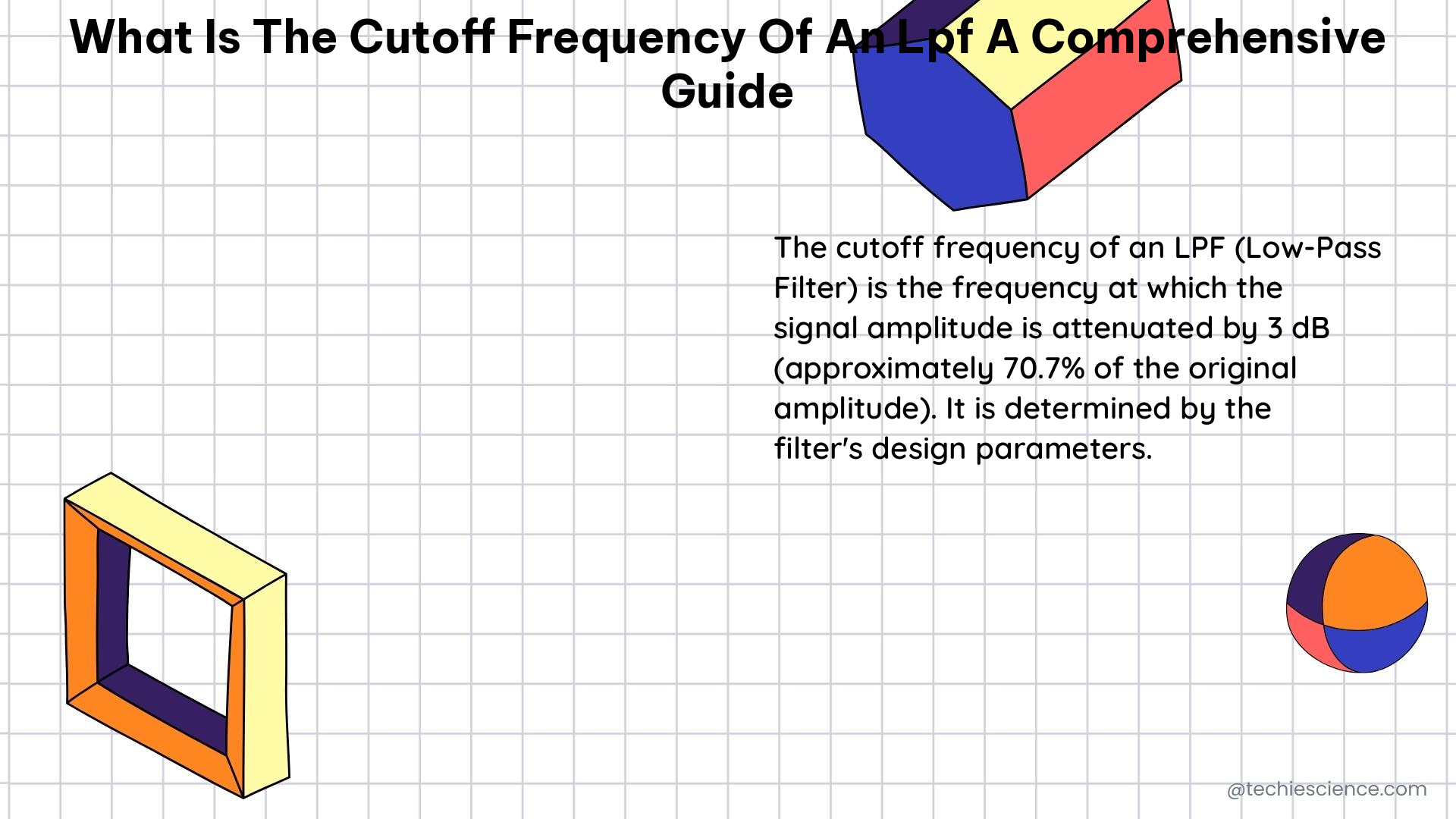The cutoff frequency of a low-pass filter (LPF) is a crucial parameter in electronics and signal processing, as it determines the boundary between frequencies that are passed through the filter and those that are attenuated. This comprehensive guide delves into the theoretical and practical aspects of determining the cutoff frequency of an LPF, covering passive, active, and digital filter designs.
Passive Low Pass Filters
Passive LPFs are constructed using resistors and capacitors, with the cutoff frequency determined by the resistor (R) and capacitor (C) values. The formula for the cutoff frequency (fc) is:
fc = 1 / (2πRC)
This formula is derived from the frequency response of a first-order RC low-pass filter, which is given by:
H(jω) = 1 / (1 + jωRC)
Where ω is the angular frequency (ω = 2πf).
Electronics Examples
Consider a passive LPF with R = 1 kΩ and C = 100 nF. Using the formula above, the cutoff frequency is:
fc = 1 / (2π × 1000 × 100 × 10^-9) ≈ 159.2 Hz
Electronics Numerical Problems
- Calculate the cutoff frequency for a passive LPF with R = 2.2 kΩ and C = 220 nF.
-
Solution:
fc = 1 / (2π × 2200 × 220 × 10^-9) ≈ 328.5 Hz -
Determine the capacitor value needed for a passive LPF with R = 10 kΩ and a desired cutoff frequency of 1 kHz.
- Solution:
C = 1 / (2π × 10000 × 1000) ≈ 15.9 nF
Active Low Pass Filters

Active LPFs utilize operational amplifiers (op-amps) to achieve higher performance and flexibility. The cutoff frequency of active LPFs depends on the type of filter circuit used, such as Sallen-Key or Multiple Feedback.
Sallen-Key Low Pass Filter
The Sallen-Key filter is a popular active LPF topology. The cutoff frequency is determined by the resistor and capacitor values, as well as the op-amp’s gain-bandwidth product. The formula for the cutoff frequency is:
fc = 1 / (2π × R1 × R2 × C1 × C2) × √(1 - 1 / (2 × Aol))
Where Aol is the op-amp’s open-loop gain.
Multiple Feedback Low Pass Filter
The Multiple Feedback filter is another active LPF topology. The cutoff frequency is given by:
fc = 1 / (2π × R1 × C1 × (1 + R2 / R3))
Electronics Numerical Problems
- Calculate the cutoff frequency for a Sallen-Key LPF with R1 = 1 kΩ, R2 = 10 kΩ, C1 = C2 = 100 nF, and Aol = 100,000.
-
Solution:
fc = 1 / (2π × 1000 × 10000 × 100 × 10^-9 × 100 × 10^-9) × √(1 - 1 / (2 × 100000)) ≈ 159.2 Hz -
Determine the resistor values needed for a Multiple Feedback LPF with C1 = 100 nF, C2 = 1 nF, and a desired cutoff frequency of 1 kHz.
- Solution:
R1 = 1 / (2π × 1000 × 100 × 10^-9 × (1 + R2 / R3)) ≈ 15.9 kΩ
Digital Low Pass Filters
Digital LPFs are implemented using digital signal processing techniques, where the cutoff frequency is determined by the filter coefficients and the sampling rate. Common digital LPF structures include Finite Impulse Response (FIR) and Infinite Impulse Response (IIR) filters.
Finite Impulse Response (FIR) Low Pass Filter
FIR filters are characterized by a linear phase response and are generally more stable than IIR filters. The cutoff frequency is determined by the filter coefficients and the sampling rate. The formula for the cutoff frequency is:
fc = fs / (2 × N)
Where fs is the sampling rate and N is the filter order.
Infinite Impulse Response (IIR) Low Pass Filter
IIR filters have a non-linear phase response but can achieve sharper cutoff frequencies than FIR filters. The cutoff frequency is determined by the filter coefficients and the sampling rate. Common IIR filter structures include the Butterworth, Chebyshev, and Elliptic filters.
Electronics Numerical Problems
- Calculate the cutoff frequency for an FIR LPF with a sampling rate of 10 kHz and a filter order of 100.
-
Solution:
fc = 10000 / (2 × 100) = 50 Hz -
Design a Butterworth IIR LPF with a cutoff frequency of 1 kHz and a sampling rate of 10 kHz.
- Solution: The filter coefficients for a Butterworth IIR LPF with a cutoff frequency of 1 kHz and a sampling rate of 10 kHz can be calculated using digital filter design tools or MATLAB/Python functions. The specific coefficients will depend on the filter order and implementation details.
By understanding the theoretical and practical aspects of determining the cutoff frequency of an LPF, electronics students can confidently design and analyze various types of filters for diverse applications, such as audio processing, image filtering, and control systems.
References
- Oppenheim, A. V., Willsky, A. S., and Young, I. T., Signals and Systems, Prentice Hall.
- Sedra, A. S., and Smith, K. C., Microelectronic Circuits, Oxford University Press.
- Park, S., and Lee, S., Digital Signal Processing: Fundamentals and Applications, Springer.
- Analog Devices: Understanding Analog Filter Design
- Texas Instruments: Active Low-Pass Filter Design
- National Instruments: Fundamentals of Digital Filters

The lambdageeks.com Core SME Team is a group of experienced subject matter experts from diverse scientific and technical fields including Physics, Chemistry, Technology,Electronics & Electrical Engineering, Automotive, Mechanical Engineering. Our team collaborates to create high-quality, well-researched articles on a wide range of science and technology topics for the lambdageeks.com website.
All Our Senior SME are having more than 7 Years of experience in the respective fields . They are either Working Industry Professionals or assocaited With different Universities. Refer Our Authors Page to get to know About our Core SMEs.